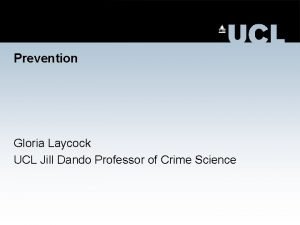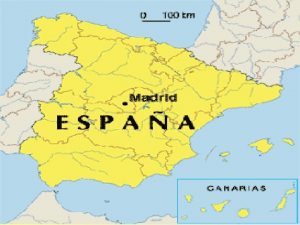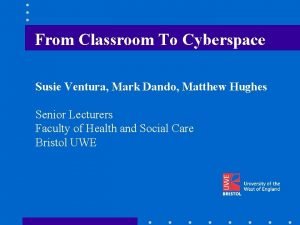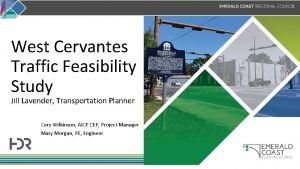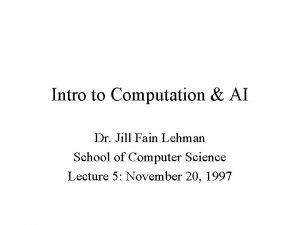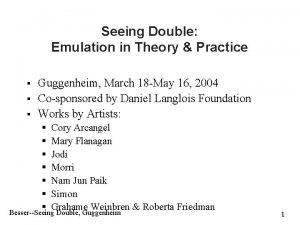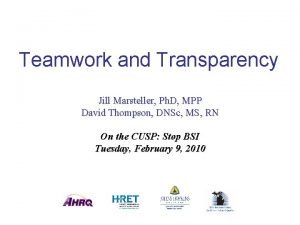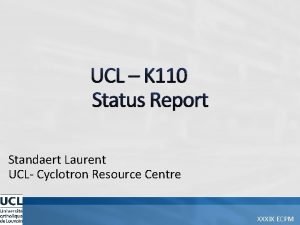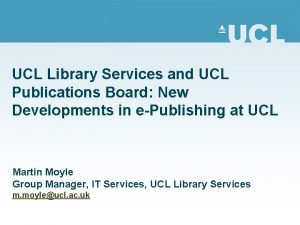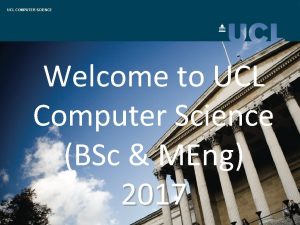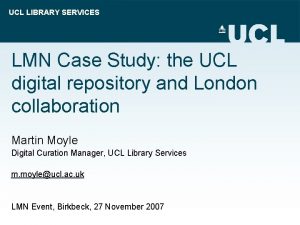Prevention Gloria Laycock UCL Jill Dando Professor of



















- Slides: 19

Prevention Gloria Laycock UCL Jill Dando Professor of Crime Science

Agenda • Why prevent? • What works? • The future

The limits of conventional policing We can not control crime using the CJS Most offenders do not get caught If you want crime down you do something else

Crime drop in Scotland from 1992 -2014/15 (Data from Scottish Criminal Justice Survey 2014/15, Appendix Table A 1. 1, p. 99)

Thinking scientifically • Using scientific methods – – Scanning Analysis Response Assessment • Testing hypotheses • Establishing knowledge

Two kinds of offender • ‘Opportunistic’ offenders: easily deterred but many of them • ‘Proper’ or ‘professional’ offenders: not easily deterred but much fewer of them

Twenty-five techniques of situational crime prevention Increase the effort 1. Harden targets 2. Control access to facilities 3. Screen exits 4. Deflect offenders 5. Control tools/weapons Reduce Provocations 16. Reduce frustrations and stress 17. Avoid disputes 18. Reduce emotional arousal 19. Neutralise peer pressure 20. Discourage imitation Increase the risks 6. Extend guardianship Remove excuses 7. Assist natural surveillance 21. Extend guardianship 8. Reduce anonymity 22. Assist natural surveillance 9. Utilise place managers 23. Reduce anonymity 10. Strengthen formal surveillance 24. Utilise place managers 25. Strengthen formal surveillance Reduce the rewards 11. Conceal targets 12. Remove targets 13. Identify property 14. Disrupt markets 15. Deny benefits

What does all this mean for crime reduction? • You need to know what works, for whom, in what circumstances and how • You need to know how best to implement it • You need to know what it might cost in your circumstances • YOU NEED TO THINK – we are looking for evidence informed judgement

EMMIE summarises the available evidence relating to the 5 key questions E = Effects found M = Mechanisms identified (how a measure works) M = Moderators identified (conditions needed to activate mechanisms) I = Implementation (what was found to be needed to put the measure in place) E = Economy (costs and returns on costs of the measure)


Summary • The output from this exercise will not tell you what works • It will tell you what might work, where and how; how you might implement it and what it might cost • It is not a substitute for thinking, experience, knowledge or skills – but it can enhance them • It is based on the best available research we have but the research base is far from complete

And the future…. . ?

We can expect increasing problems from…. • The Internet – Paedophilia, fraud, hacking, stalking etc. • • Drones The Internet of Things Alternative currencies…. etc Generally, things most of us don’t understand but some offenders are getting the hang of…. and those offenders may be here or based in other countries

Will Smart Cities be Safe Cities? (Innes, M. (2015) Presentation at What Works meeting, Edinburgh, 04. 02. 16) Key emerging themes from the ‘Smart Cities/Safe Cities’ project: Crime prevention and public safety are not high on the agenda; A range of catastrophic and mundane criminogenic risks are being designed into the ‘informational wrapper’ of the new urban fabric; Benefits of smart cities are mostly framed in terms of economy and environment; Who ‘owns’ the risk is an issue of responsibility and competency – corporates want government to, government wants private sector; This lack of a strategic crime prevention perspective means that solutions may need to be retrofitted

A note of caution • Over-reaction is a risk in itself • Make sure future crime prevention strategies are ethical, legitimate and proportionate • Be alert to public sensitivities about police tactics, data protection, excessive surveillance • Nobody wants to live in a surveillance society, police state, or a country where social and educational policies no longer put the welfare of families and children first

What to do? • Look to developments in technology and social change and try to pre-empt problems • Better inform the public (and the police) about protection • Develop new methods of data collection with early warning in mind • Prepare for an uncertain world with rapid changes – Act quickly – Establish structures that facilitate rapid action – Learn how to lever action from the private sector

Future policing • • • Embrace problem solving Learn from research evidence and from mistakes Review training needs Build a knowledge base Be a learning organisation – create knowledge

input Scanning Analysis Response (in consultation with partners) Assessment Knowledge Bank Data collection Community consultation Search of research base Stakeholders identified Crime mapping Big data analytics Partnership working Hypothesis testing Increase effort Increase risk Reduce rewards Reduce provocation Remove excuses Statistical analysis Research methods Cost benefit analysis Report writing Communication skills POP projects Research-based evidence on what works, what doesn’t, where and how Theft Burglary Car crime output Drugs Alcohol Violence Cyber crime Poor police/community relations Etc. Repeat victims Police patrol Restorative justice Near repeats Secure parking Open drugs markets New technologies Poorly managed pubs Engage with private sector Targeted deterrence Etc. Hot spots knives etc…. SARA is an iterative process – unexpected outcomes should prompt reversion to earlier stages of analysis and/or response. Reduction in crime/ Disorder/presenting problem Increase in scale of problem No effect Implementation failure Measurement failure Unexpected outcome A Learning organisation

Thank you http: //www. ucl. ac. uk/scs/what-works-commissioned-partnership-programme
 Gloria laycock
Gloria laycock Perdoai me outra vez senhor
Perdoai me outra vez senhor Primary prevention secondary prevention tertiary prevention
Primary prevention secondary prevention tertiary prevention Cantemos glória glória a deus nas alturas
Cantemos glória glória a deus nas alturas Gloria gloria corona de la patria
Gloria gloria corona de la patria Mineiro dando má notícia
Mineiro dando má notícia Mark dando australia
Mark dando australia Mark dando
Mark dando Promotion from assistant to associate professor
Promotion from assistant to associate professor Classdoj
Classdoj Jill lavender
Jill lavender Jill weigel
Jill weigel Root word examples
Root word examples Jill johnston usc
Jill johnston usc Jill marano
Jill marano Jill fain lehman
Jill fain lehman Jack and jill french revolution
Jack and jill french revolution Jill friedman-guggenheim
Jill friedman-guggenheim Jill marsteller
Jill marsteller Estelle oldham jill faulkner
Estelle oldham jill faulkner
